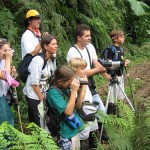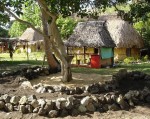 At the turn of the century, in the early 1900s, to go on safari meant one would travel to the far corners of the world, armed with the guidance of an indigenous tracker and large caliber rifle. It is no secret that the rich and royal killed hundreds of animals during a single trip to Africa, India, or Indonesia, and relished in doing so. Even Theodore Roosevelt, President of the United States and founder of America’s most beautiful natural parks was an avid safari hunter; elephant tusks and a leopard rug adorned the oval office when Teddy was Commander in Chief. Today, some of those same species, i.e. lion, leopard, elephant, tiger, etc., that were well sought after safari targets have gained popularity for another reason; these same animals now top the endangered species list.
At the turn of the century, in the early 1900s, to go on safari meant one would travel to the far corners of the world, armed with the guidance of an indigenous tracker and large caliber rifle. It is no secret that the rich and royal killed hundreds of animals during a single trip to Africa, India, or Indonesia, and relished in doing so. Even Theodore Roosevelt, President of the United States and founder of America’s most beautiful natural parks was an avid safari hunter; elephant tusks and a leopard rug adorned the oval office when Teddy was Commander in Chief. Today, some of those same species, i.e. lion, leopard, elephant, tiger, etc., that were well sought after safari targets have gained popularity for another reason; these same animals now top the endangered species list.
Recently, a new type of safari has emerged; exotic journeys that allow some of the world’s most majestic creatures to be observed through the lens of a camera and not the cross-hairs of a rifle scope. Ecotourism has been an international success story in generating revenue for well needed wildlife conservation and habitat preservation programs, and to help indigenous people. Although ecotourism has generated a lot of support, proponents claim that in some cases it is nothing more than the blatant exploitation of an indigenous people and a complete detriment to the environment. Bringing visitors and needed awareness and funds to areas of extreme ecological importance, is ecotourism a conservation friend or foe?
observed through the lens of a camera and not the cross-hairs of a rifle scope. Ecotourism has been an international success story in generating revenue for well needed wildlife conservation and habitat preservation programs, and to help indigenous people. Although ecotourism has generated a lot of support, proponents claim that in some cases it is nothing more than the blatant exploitation of an indigenous people and a complete detriment to the environment. Bringing visitors and needed awareness and funds to areas of extreme ecological importance, is ecotourism a conservation friend or foe?
Situated between pristine park land and cattle grazing areas in Nanyuki, Kenya, the Il Ngwesi Lodge is considered a role model for community based tourism. Ran by a Masai community, Il Ngwesi gives visitors a chance to get an up close and personal view of elephant, rhino, lion, and water buffalo in their natural surroundings. Guests can also walk to local villages for a once-in-a-lifetime experience of Masai culture. Although described as a “magical hidden paradise” by one guest, one particular British National said her trip to the lodge was “the worst experience one could imagine.” In 2008, a British tourist went for an early morning run while staying at Il Ngwesi. On her return to the lodge the visitor met an elephant in her path. The elephant began to charge causing the woman to fall and thereby initiating an attack. The elephant gored the woman in the torso and leg resulting in severe injury and subsequent lawsuit; the Brit was awarded one million dollars US for compensation. One could argue that it was the lodge’s responsibility to ensure all guests remain safe regardless of activity. However, one cannot go on holiday to Kenya and not be aware of the risks of wild animal encounters. Wildlife-Human conflicts that result in injury always make international headlines, more times than not generating fear and hatred toward the animal involved. Moreover, what about the native Kenyans who are injured or die each year from confrontations with wild animals? These individuals are not compensated with such a large sum of money. Does this reaction anger local people against international tourism? How does this help in conservation?
A popular activity on ecotourism vacations is to observe animals displaying natural behaviors such as caring for young, hunting prey, challenging rivals for territory and breeding rights, etc.; a live feed of the National Geographic channel. For a cheetah in the Masai Mara, hunting prey is an energy expensive venture. In temperatures over 43° Celsius (110° Fahrenheit), the cheetah runs in short sprints reaching 70 miles an hour to catch prey such as a Thompson’s gazelle. After quickly dispatching its victim the cheetah has to guard its well-earned dinner for hours until it recuperates from almost complete exhaustion. How stressful it must be for that same cheetah to suddenly be surrounded by buses full of holiday makers and the snapping and flashing of cameras to immortalize the moment? Would those same travelers not feel the same connection and need to conserve this animal and its habitat from a visit to the zoo or a picture in a book?
rivals for territory and breeding rights, etc.; a live feed of the National Geographic channel. For a cheetah in the Masai Mara, hunting prey is an energy expensive venture. In temperatures over 43° Celsius (110° Fahrenheit), the cheetah runs in short sprints reaching 70 miles an hour to catch prey such as a Thompson’s gazelle. After quickly dispatching its victim the cheetah has to guard its well-earned dinner for hours until it recuperates from almost complete exhaustion. How stressful it must be for that same cheetah to suddenly be surrounded by buses full of holiday makers and the snapping and flashing of cameras to immortalize the moment? Would those same travelers not feel the same connection and need to conserve this animal and its habitat from a visit to the zoo or a picture in a book?
A trip to Belize gives tourists a glimpse into lush rainforest habitat and the lives of unique animals. For the most part, visitors are happy to leave with simple memories and pictures to commemorate their adventures. Unfortunately, for some, a picture souvenir is not enough and unbeknownst the traveler purchases something in a local shop or market that perpetuates poaching or illegal animal trade. Road ways and hiking trails for paying visitors also doubles as easy access to forest areas for collection of endangered species, poaching for the bushmeat trade, and the harvesting of native timber. Are the ecological costs outweighing the benefit?
with simple memories and pictures to commemorate their adventures. Unfortunately, for some, a picture souvenir is not enough and unbeknownst the traveler purchases something in a local shop or market that perpetuates poaching or illegal animal trade. Road ways and hiking trails for paying visitors also doubles as easy access to forest areas for collection of endangered species, poaching for the bushmeat trade, and the harvesting of native timber. Are the ecological costs outweighing the benefit?
 But is ecotourism really that bad? Without a doubt, in all ventures, you will always have those individuals who will manipulate the system and not adhere to ground rules set to ensure species protection and conservation, habitat preservation, and improvement of the welfare of local people. I think that ecotourism can be extremely beneficial in a multitude of ways. In the Democratic Republic of Congo the poaching of gorillas for the bushmeat trade has skyrocketed. Endangered Species International estimates that 300 gorillas are sold to local markets for food or novelty items; gorilla hands are often fashioned into ashtrays. Sold both locally and internationally, approximately 454 g (1 lb) of gorilla meat generates $6.00 US. Ecotourism via gorilla tracking trips helps protect the natural habitat of these amazing creatures as well as places a premium on each animal making them more valuable alive than dead. Likewise, gorilla scouting trips in Rwanda and Uganda have not only increased local revenue significantly, but also gives people a sense of national pride and has aided in cultural reconstruction. This is especially true for Rwanda, a country who saw its people, natural areas, and wildlife torn apart during the genocide of 1994. Rwandans have gained worldwide respect for their passion and hard work for gorilla conservation and habitat preservation.
But is ecotourism really that bad? Without a doubt, in all ventures, you will always have those individuals who will manipulate the system and not adhere to ground rules set to ensure species protection and conservation, habitat preservation, and improvement of the welfare of local people. I think that ecotourism can be extremely beneficial in a multitude of ways. In the Democratic Republic of Congo the poaching of gorillas for the bushmeat trade has skyrocketed. Endangered Species International estimates that 300 gorillas are sold to local markets for food or novelty items; gorilla hands are often fashioned into ashtrays. Sold both locally and internationally, approximately 454 g (1 lb) of gorilla meat generates $6.00 US. Ecotourism via gorilla tracking trips helps protect the natural habitat of these amazing creatures as well as places a premium on each animal making them more valuable alive than dead. Likewise, gorilla scouting trips in Rwanda and Uganda have not only increased local revenue significantly, but also gives people a sense of national pride and has aided in cultural reconstruction. This is especially true for Rwanda, a country who saw its people, natural areas, and wildlife torn apart during the genocide of 1994. Rwandans have gained worldwide respect for their passion and hard work for gorilla conservation and habitat preservation.
 If you are an avid scuba diver, and have visited the southeastern coast of the United States or the Caribbean Islands in the last 10 years you have noticed the increasing frequency in sighting a veracious, non-native predator. The lion fish may be popular for amateur aquarists for their bright stripes and fanlike pectoral fins, but this species has gained a reputation in the wild as a huge problem. Native to the Indo-Pacific Oceans, it is thought that unwanted lion fish were introduced to non-native waters by irresponsible owners who no longer wanted them and from aquarium escapes during Hurricane Andrew into the Gulf of Mexico in 1992. The spines hidden in the fins of this fish contain venom glands, making the lion fish extremely dangerous. In addition, the lion fish is aggressive and has a large, nondiscriminatory appetite; the lion fish will eat anything that it can fit inside its mouth. Although small in size in a captive setting, the lion fish will grow as its habitat allows; lion fish found in the Caribbean Sea have been documented as large as 42 cm (1.4 ft) in length. With a life expectancy of up to 15 years and capability of producing 15,000 young every year, some invaded areas have seen almost a 1000% increase in population size of the lion fish in just five years. So how does ecotourism fit into this picture? To ensure sustainability of reef fish population and local diving and snorkeling industries, lion fish need to be removed. Ecotourism trips for experienced divers to collect lion fish during dives have become very popular. At present, tens of thousands of fish are removed from non-native waters annually. Furthermore, captured lion fish are turning into a culinary favorite as they are now showing up on menus and dinner tables. Visiting divers are not only bringing needed money to these areas, but are also leaving the waters safer by removing an unwanted menace.
If you are an avid scuba diver, and have visited the southeastern coast of the United States or the Caribbean Islands in the last 10 years you have noticed the increasing frequency in sighting a veracious, non-native predator. The lion fish may be popular for amateur aquarists for their bright stripes and fanlike pectoral fins, but this species has gained a reputation in the wild as a huge problem. Native to the Indo-Pacific Oceans, it is thought that unwanted lion fish were introduced to non-native waters by irresponsible owners who no longer wanted them and from aquarium escapes during Hurricane Andrew into the Gulf of Mexico in 1992. The spines hidden in the fins of this fish contain venom glands, making the lion fish extremely dangerous. In addition, the lion fish is aggressive and has a large, nondiscriminatory appetite; the lion fish will eat anything that it can fit inside its mouth. Although small in size in a captive setting, the lion fish will grow as its habitat allows; lion fish found in the Caribbean Sea have been documented as large as 42 cm (1.4 ft) in length. With a life expectancy of up to 15 years and capability of producing 15,000 young every year, some invaded areas have seen almost a 1000% increase in population size of the lion fish in just five years. So how does ecotourism fit into this picture? To ensure sustainability of reef fish population and local diving and snorkeling industries, lion fish need to be removed. Ecotourism trips for experienced divers to collect lion fish during dives have become very popular. At present, tens of thousands of fish are removed from non-native waters annually. Furthermore, captured lion fish are turning into a culinary favorite as they are now showing up on menus and dinner tables. Visiting divers are not only bringing needed money to these areas, but are also leaving the waters safer by removing an unwanted menace.
 No matter the industry, if there is a demand for a product or an experience then those profiting from that demand will ensure it is met. We see this all too often with the illegal trade of wildlife products, drugs and weapons, but this is also true for ecotourism. Regardless where you live, all people want to alleviate suffer from their lives; to raise their families in a safe environment and send their children to bed happy, healthy, and with full tummies. Ecotourism has promise in helping native people to live better lives and learn skills, as well as conserve wildlife and protect habitats. The key to success is making sure all ecotourism follows protocol that propagates “responsible travel to natural areas which conserves the environment and improves the welfare of local people.” It is the responsibility of not only those governing bodies of ecotourism and individual tour operators, but also to those travelers partaking in such adventures. Getting back to nature is a primitive desire in all of us. Our actions today will ensure there are places to go back to tomorrow.
No matter the industry, if there is a demand for a product or an experience then those profiting from that demand will ensure it is met. We see this all too often with the illegal trade of wildlife products, drugs and weapons, but this is also true for ecotourism. Regardless where you live, all people want to alleviate suffer from their lives; to raise their families in a safe environment and send their children to bed happy, healthy, and with full tummies. Ecotourism has promise in helping native people to live better lives and learn skills, as well as conserve wildlife and protect habitats. The key to success is making sure all ecotourism follows protocol that propagates “responsible travel to natural areas which conserves the environment and improves the welfare of local people.” It is the responsibility of not only those governing bodies of ecotourism and individual tour operators, but also to those travelers partaking in such adventures. Getting back to nature is a primitive desire in all of us. Our actions today will ensure there are places to go back to tomorrow.